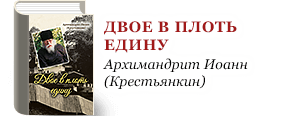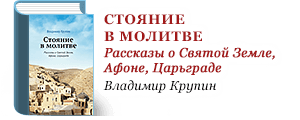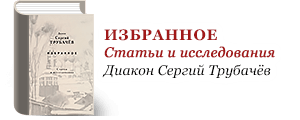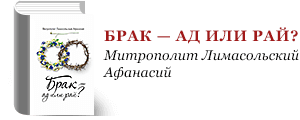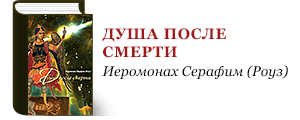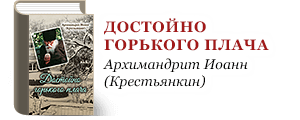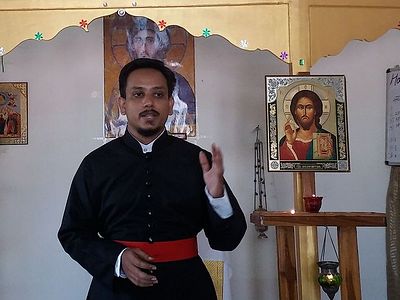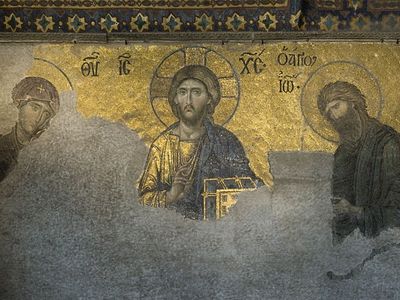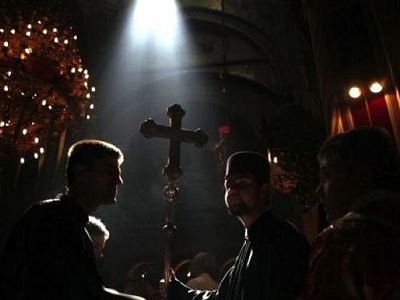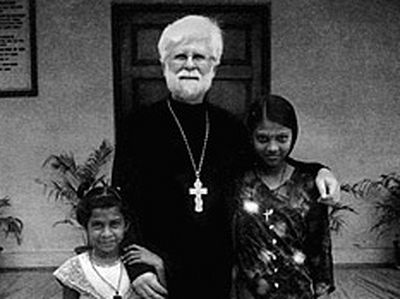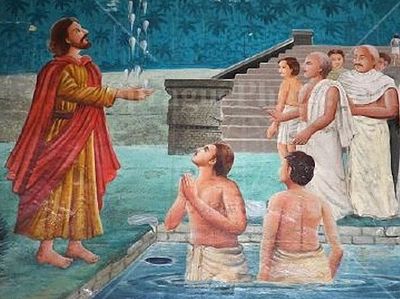In early 2015, Pravoslavie.ru posted in both Russian and English an article by Clement Nehamaiyah on his path to the Orthodox Church. To our pleasant surprise, we learned that the article was read in India and prompted an Indian non-Chalcedonian Christian to write a letter to Clement in which he attempts to prove that the “Indian Orthodox Church” is the true Church of Christ as it was brought to India by the Apostle Thomas. We asked Clement to answer this very interesting letter, and his brother Polycarp, who became Orthodox together with his brother, responded.
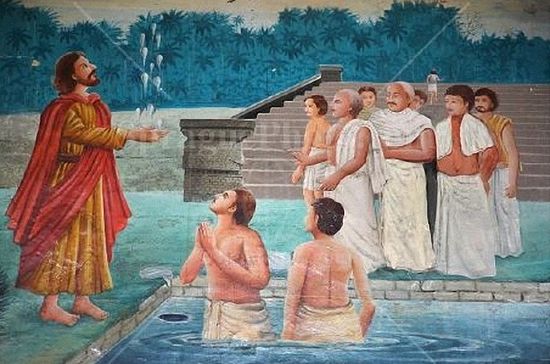 The Apostle Thomas, preaching in India.
The Apostle Thomas, preaching in India.
"I was shocked to read this."
A letter from the non-Chalcedonian Basil Varghese
Dear Clement,
Greetings in the name of our Lord!
I happened to read your letter entitled, “The Indian Mission will be the most fruitful mission in the world”. First of all, I congratulate you on finding the Truth in the Orthodox Church.
I see that you mention your knowledge about the “monophysitic” “jacobites” “who call themselves Orthodox” in India. Let me register the shock I felt on reading that. I personally belong to the Indian Orthodox Church, founded by the Apostle St. Thomas himself. The Primate Patriarch of this Church is the Catholicos of the East, successor to the Apostolic Throne of St Thomas. At present, His Holiness Baselios Mar Thoma Paulos II is the reigning Patriarch. Until the Portuguese came to India in 1498 and started trying to dominate the native Christians through the next century, my Church was in close contact with the Persian Church (which was also founded by St. Thomas). So it is safe to assume that our forefathers’ faith might have been Nestorian. But after half a century of Catholic domination (1599-1653), my Church declared independence through the Oath of Slanting Cross in 1653, which was the FIRST open revolt in India against foreign colonial domination. Then my Church sent letters to other Churches of the East for help—we had no bishops. Only the Syriac Orthodox Church responded. After more than two centuries of acquaintance with Syriac bishops, my Church slowly absorbed their liturgy and adopted it fully by the 19th century.
Please understand that the Oriental Orthodox Churches are NOT monophysites. If you examine the historical and political backdrop of the Synod of Chalcedon (how Patriarch Anatolius of Constantinople was cowed into accepting the Tome of Leo by Empress Pulcheria, how a power-hungry bishop of Rome decided to take revenge on the unassuming Patriarch of Alexandria—note that the same hunger for power by the Roman Pope was a key factor in the Great Schism) and study carefully about “in two natures” versus “from two natures”, you will understand the truth. Basically, the Byzantine Orthodox and the Oriental Orthodox have the same faith, only expressed in slightly different ways, which has caused confusion. Please read the minutes of the Chambesy Agreement.
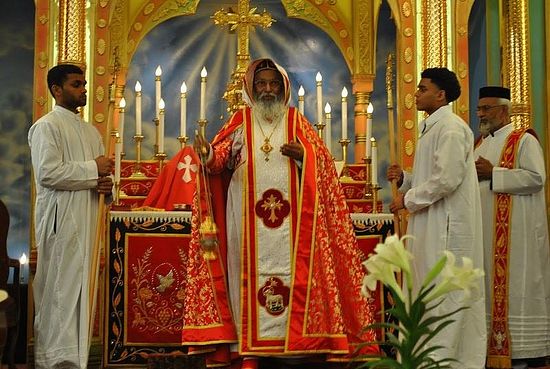 A service in the Malankara Church.
A service in the Malankara Church.
You can also refer to the works of the famous Reverend Father Dr. V. C. Samuel and the celebrated Metropolitan Paulos Mar Gregorios, which shed light on these matters.
Also, the name “Jacobite” is derogatory. We shed that name about a century ago. It was used by the “Melkites” to mock us for our affinity to Jacob Baraddaeus who was anti-Chalcedonean. (See how you dislike being called “Melkites”? In the same way, we dislike being addressed “Jacobites”.)
Right now, considering the extremism being revealed by Hindus, please understand that it is time for the Christians of India to stand united. I am from Kerala. Even in your state Maharashtra, the Indian Orthodox Church has a strong diocese with a Metropolitan's See at Mumbai. At Nagpur, we have a prestigious seminary (St. Thomas Orthodox Theological Seminary). Please join me in my prayer for the re-establishment of Communion between the Eastern Orthodox Church and the Oriental Orthodox Church. We have high hopes in the goodness of His Holiness H. Patriarch Kirill and His Eminence Metropolitan Hilarion Alfayev. The former Patriarch His Holiness Alexey II was a great friend of the Indian Orthodox Church. Right now, the Russian Orthodox priest Father Dr. Stephen Headley is on a visit to a monastery of Indian Orthodox Church at Kottayam, Kerala. Let us pray for growing fraternity between the Eastern and Oriental Churches.
Yours in Christ,
Basil Varghese
Kerala, India
“We are made inheritors of the Apostle Thomas only through unbroken succession.”
The answer from an Orthodox Christian in India, Polycarp Nehamaiyah
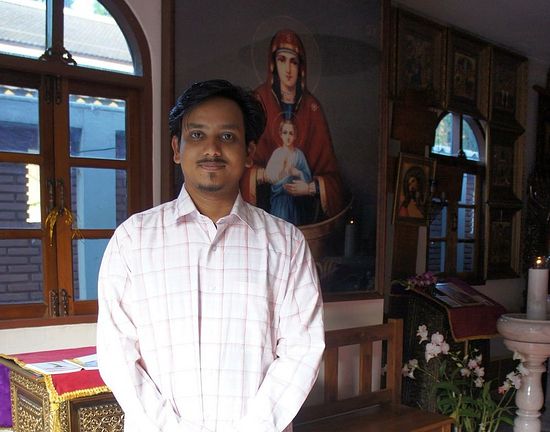 Polycarp Nehamaiyah.
Polycarp Nehamaiyah.
Dear Sir,
Greetings in the name of Most Holy of Jesus Christ!
I am glad to know that my testimonial letter was read in India. I am also glad to receive your response to which I am replying with brotherly love. I can understand your shocked reaction being a member of the Oriental Orthodox Church. If I were an Anglican today, maybe I would have felt similarly, but that would have been out of a feeling of zeal for my sect, but nevertheless a feeling without insight into fuller truth and its experience. There are multiple angles to see or judge a thing, that is, the completely wrong angle, the partially right and partially wrong angle, and completely right angle. People looking through each of these angles think that they are right and their point of view is correct; however, what matters is not what people think about a certain thing from their point of view but what the truth is. This is especially important when we talk about “The” Christian faith, which is the life of the Holy Spirit in the Church of Blessed Trinity. And for this reason we must have the right angle to see and judge a matter unto the glory of God, instead of blasphemy. As an Orthodox I disagree not only with the history you stated but also with the theology; but I assure you my reaction of disagreement and reply to you is only out of love and concern for my beloved fellow believer in Christ.
I have studied Indian Church history and based on that I can safely say that The Malankara Orthodox Syrian Church, also known as Indian Orthodox Church, was split from the Jacobite Syrian Christian Church, which is in communion with and is under Syriac Orthodox Patriarchate. Thus, as far as history is concerned, the Malankara Orthodox Syrian Church came into existence in 1912 instead of 1 A.D., as is commonly claimed by the faithful of the said church. The current head of the church His Holiness Baselios Mar Thoma Paulose II is known as the Catholicos of the East and Malankara Metropolitan, rather than the Patriarch. Basically, in truth no Christian body in India can claim to be the Church established by Apostle Thomas. Apostle Thomas established the Orthodox Church in India, but after his martyrdom, for 300 years the Church of St. Thomas remained without priests, dependent on the Persian Church, which was also Orthodox at that time but became Nestorian in 489 A.D.—more specifically after the death of Patriarch Acacius, who was the last Orthodox Patriarch of the See of Seleucia-Ctesiphon. Since the Indian Church was overseen by the Persian Church, it also became Nestorian under its leadership. At the end of the sixteenth century, Portuguese Roman Catholics arrived and converted most of the existing Nestorian church, while a small portion remaining separate from the Latin Church became Miaphysite Oriental Orthodox in 1665 after receiving the Syriac Orthodox bishop of Jerusalem Gregorios Abdul Jalil, Syriac Patriarchate. The reason I state this history is to show that the Church of St. Thomas died in the 5th century and remained dead during Latin and Jacobite conversion. Therefore, as I said before, no Christian body in India can lay claim to being the Church established by Apostle Thomas. It’s not the succession or continuity of genealogy or mere laying on of hands that matters or makes us successors of Apostles but the continuity of faith, not in a similar faith, nor almost identical faith, but in an exactly identical faith, which is the life and work of the Holy Spirit—the One Lord having One Body inhabited by One Spirit who carries One Faith in the ever present Bride of Christ.
Now, concerning the controversy of Chalcedon, I would say it’s an already solved issue. I have read the book by Dr. V. C. Samuel entitled, The Council of Chalcedon Reconsidered, and I must admit it’s an interesting book. But again I would like to emphasize looking from the right angle to avoid error. I agree that commonly Orientals are referred to as Monophysites which Orientals [Orthodox] find derogatory and which is also not entirely accurate term to designate Orientals, so it’s better to call Orientals Miaphysites as I saw Coptic Pope Shenouda III preferring, or simply non-Chalcedonians.
By the way, “Jacobite” is not derogatory term as the Jacobite Syrian Christian Church uses it for itself, and neither is the term “Melkite” derogatory for me. As long as the Emperor, any Church hierarch, or even layman is Orthodox, I have no problem calling myself after his name. Anyways, the Chambesy Agreement you talked about is not honest to the truth, neither is it accepted by the Russian Orthodox Church, nor by Mount Athos. We do desire healing of all schisms but it should be with truthfulness and honesty towards the life of the Holy Spirit otherwise we only deceive ourselves into false union. The Church is a living entity; she is never past, she is always in the present, because she possesses the fullness of Christ and the continuous life of His Spirit. The Most Holy Body of Christ has already defended and proclaimed the faith of the Son of God that the Hypostatic Union of the Incarnate Logos is not only “of two natures'' but also is “in two natures'”—the one and the only Christ, the Only begotten Son of God. The definition of Chalcedon proclaims the Orthodox faith to which the prophets of old testified. Thus the Lord Jesus Christ himself taught us; thus was the Symbol of the Fathers handed down to us. So also is the Tome of Pope St. Leo. I personally love this Tome, for it beautifully and with simplicity explains Hypostatic Union. The Tome of St. Leo was not forced on the Church by the Empress. How could it be? Even if we assume that St. Anatolius of Constantinople was cowed into accepting the Tome, how would we explain that after reading the Tome, all of the Bishops cried out, “This is the faith of the fathers; this is the faith of the Apostles. So we all believe, thus the Orthodox believe”? Furthermore, St. Anatolius himself was an Alexandrian, educated in the Alexandrian school. He knew the distinction between the Orthodox and non-Orthodox Christology, and thus he clung to the Christology expounded in the Tome and rejected the contradiction along with other bishops. It is an error to say the Eastern and Orientals have the same faith, for how can the Tome of St. Leo be Orthodox and heretical at the same time?
The Church canonized Pope Leo as Saint and doctor of the Church, but condemned Dioscorus and Severus. The act of the Church makes it crystal clear what the Orthodox faith is and what it is not. That is why any assumption of our faith being same is alien to the Church of Christ. The question of Chalcedon is very important and we must not take it lightly because Jesus asks us, Who do you say that I am? (Matt 16:15). Our answer determines whether it is from the Father in Heaven or from our intellect. St. Vincent of Lerins helps us determine the Orthodoxy of our faith. He says, “In the catholic Church itself, all possible care must be taken that we uphold the faith that has been believed everywhere, always, and by all. For that is truly and in the strictest sense catholic; which, as the name itself and the reason of the thing declare, comprehends all universally. This rule we shall observe if we follow universality, antiquity, and consent. We shall follow universality if we confess to be true the one faith that the whole Church throughout the world confesses; antiquity, if we in no wise depart from those interpretations which it is manifest were notoriously held by our holy ancestors and fathers; consent, in like manner, if in antiquity itself we adhere to the consentient definitions and determinations of all, or at the least of almost all priests and doctors. (Commonitorium of St. Vincent of Lerins, Ch.2)
The healing of schism and restoration of communion is truly desired and looked for but it cannot be achieved until attempts are made seriously, faithfully, honestly and being of one mind with the Church. It’s truly a blessed act to pray for the re-union and we do pray for it always. Let us continue praying for this cause. I also appreciate your call for being united in India in this time of tensions. Indeed, we must stand united, helping each other, praying for each other and giving witness of Christ together, so that the name of our Lord and God may be glorified through all and in all. Amen.
In Christ,
Polycarp
